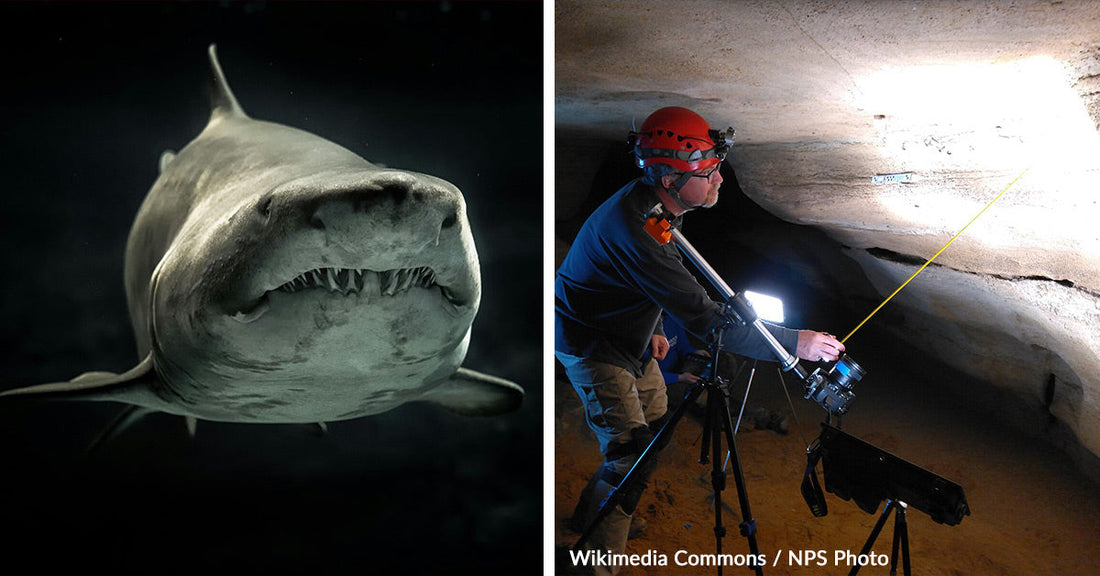7th Annual Holiday Toy & Book Event Help make the holidays brighter this year!
Ancient Sharks Resurface After 325 Million Years Beneath Kentucky
Matthew Russell
Long before Kentucky became farmland and forest, it was sea. A vast, shallow seaway once stretched across the region, connecting eastern North America with what we now know as Europe and North Africa. Beneath its ancient waters, sharks thrived. Now, in the dark limestone passageways of Mammoth Cave, their fossilized remains are coming to light.
A recent wave of discoveries inside the world’s longest known cave system has revealed three previously unknown shark species. These finds, preserved for over 325 million years, provide a rare glimpse into the prehistoric marine ecosystems that once covered the southeastern United States.

Photo: Wikimedia Commons / NPS Photo, License: Public Domain
Three new species of ancient sharks were discovered in Mammoth Cave, Kentucky.
Troglocladodus Trimblei: The Cave Branching Tooth
The first of these new sharks, Troglocladodus trimblei, was identified from teeth found in both Kentucky’s St. Louis and Ste. Genevieve rock formations and Alabama’s Bangor Formation. This new genus and species is believed to have reached 10 to 12 feet in length—comparable to today’s oceanic whitetip shark. Its branching tooth structure helped name the species, which honors Mammoth Cave superintendent Barclay Trimble, who discovered the first fossil tooth during a 2019 survey with the Paleontological Resources Inventory (PRI), National Park Service reports.
These teeth suggest a powerful predator adapted for the shallow, reef-like waters that blanketed the region during the Mississippian subperiod. The name itself—“Cave Cladodus”—hints at its ancient connection to Mammoth Cave’s depths.

Photo: Wikimedia Commons / NPS Photo, License: Public Domain
The sharks lived over 325 million years ago when Kentucky was underwater.
Glikmanius Careforum: A Lineage Pushed Back
Another toothy revelation came with Glikmanius careforum, a new species in the extinct Glikmanius genus. While the genus was already known, this particular species extends the group’s origin back by more than 50 million years. Fossils from Mammoth Cave’s Ste. Genevieve and Haney Formations, along with Alabama’s Bangor and Hartselle Formations, provided the evidence.
In a surprising turn, researchers unearthed a partial set of jaws and gills from a juvenile Glikmanius, the first cartilage fossil of its kind ever found for the genus. According to WLWT, the shark likely had a compact head and a strong bite, ideal for hunting squid-like orthocones and smaller marine animals. Its name honors the Cave Research Foundation, whose members played a key role in the discovery.
Photo: Wikimedia Commons / NPS Photo, License: Public Domain
Troglocladodus trimblei was named after a park superintendent who found the first tooth.
Clavusodens Mcginnisi: The Nail Tooth Mini-Shark
While the other two sharks were formidable hunters, the third new discovery is remarkable for its size—or lack of it. At just 3 to 4 inches long, Clavusodens mcginnisi, or “McGinnis’ nail tooth,” is one of the smallest shark species ever recorded. Named for its rear teeth, which resemble old iron nails, this petalodont shark lived along the sea floor, feeding on crustaceans, worms, and other invertebrates.
Nicknamed “chipmunk sharks” by researchers for their unusual tooth configuration and tiny frame, these sharks likely evaded larger predators while foraging in reef-like environments teeming with marine life, Live Science reports. Their fossils were pulled from the Ste. Genevieve rock layer inside Mammoth Cave, dating back around 340 million years.

Photo: Wikimedia Commons / NPS Photo, License: Public Domain
The sharks lived in a shallow seaway that once connected several continents.
From Reef to Rock
Though Kentucky is now landlocked, Mammoth Cave’s fossil record captures a vivid picture of its marine past. The Paleontological Resources Inventory, led by ancient shark expert John-Paul Hodnett since 2019, has cataloged over 70 species of ancient fish across more than 25 cave sites, Forbes reports. These discoveries provide crucial insight into early shark evolution and the dynamics of prehistoric marine environments.
Researchers crawling through narrow cave passages are uncovering not just fossils but entire ecosystems preserved in stone. These sharks, whether giants of their time or tiny bottom dwellers, are more than relics—they're pieces of a forgotten ocean that once flowed across Kentucky.


